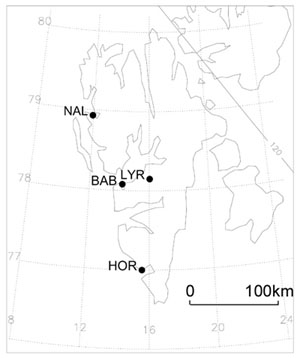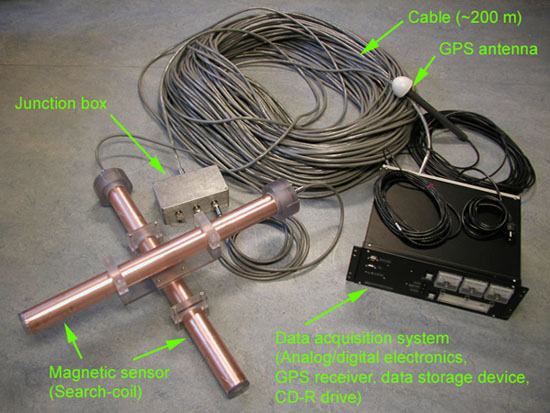Closely-Spaced Search-Coil Magnetometer Array
Database Query and Plot Generator
Old LinkSystem Status (Network connection availability)
1. Overview
Geomagnetic micropulsations are short period (usually of the order of seconds or minutes) fluctuations of the Earth's magnetic field. They are transitory variations of small amplitude (usually less than one part in ten thousand of the Earth's magnetic field) and leave no permanent effects on the field. Like longer period disturbances, such as magnetic storms, the energy that drives them is of solar origin, in contrast to the Earth's main field and secular variations which are of internal origin.
Although the solar induced wave energy in the Earth's environment (magnetosphere) is a small fraction of the energy present in the form of plasma and energetic particles (trapped radiation), waves are most important in the electrodynamics of substorms. They play a role in: transporting magnetospheric energy to the ionosphere; determining the life time of trapped radiation; accelerating particles either stochastically or in resonance; and, perhaps, even in coupling the solar wind energy itself to the magnetosphere. The micropulsation experiment is therefore an important measurement to be made at stations like Siple, South Pole, McMurdo and Sondre Stromfjord which are attempting to diagnose the magnetosphere from the ground.
The micropulsation detector consists of three (sometimes only two) orthogonal permeable core search coils and associated analog electronics. The search coils and preamplifiers are mounted in the ice (or ground) with the Z sensor (up) along the geomagnetic field line, the Y sensor (east-west) horizontal and perpendicular to the Z sensor, and the X sensor (north-south) along the geomagnetic meridian, perpenicular to the Y and Z sensors.
The search coils that are used for this project have 160,000 turn coils of number 36 copper wire mounted on 0.8 m long by 2.5 cm diameter annealed mu-metal cores. The coil gain is 150 μV/(nT Hz). Preamplifiers (gain, 121) at the coils provide mV signal levels for transmission to the data acquisition system (bufferboard of the data system gain, 244). Therefore, the system provides the gain of 4.43 V/(nT Hz). The frequency response is DC – 2.5 Hz (-3 dB corner frequency). The resolution is approximately 10 pT at a specified frequency.
Svalbard, a territory of Norway, is defined as a land area situated between 74 and 81 degrees north, between 10 and 35 degrees east and is situated within the Arctic circle (See Figure 1.1). Four search coil magnetometers are deployed in a closely-spaced, two-dimensional configuration, as shown in Figure 1.2 and Table 1.1. Longyearbyen and Ny Alesund are the major Norwegian settlements in Svalbard. UNIS (University Center in Svalbard) operates the Adventdalen auroral research station at Longyearbyen and the Norwegian Polar Institute operates a new, multi-instrument facility in Ny Alesund, which in turn is owned and managed by the Norwegian public corporation Kings Bay AS. Appropriate sites are also available at the Russian scientific station in Barentsburg, operated by the Polar Geophysical Institute, Apatity, Russia, and at the Polish Polar Station in Hornsund, operated by the Institute of Geophysics of the Polish Academy of Sciences, Warsaw.
The use of a closely-spaced two-dimensional array of search coil instruments, each with accurate GPS timing, will allow us to determine phase differences between waves observed at different sites, and hence determine apparent propagation and infer wave source locations. Waves observed at larger distances, such as those by our Antarctic search coil array, are often quite dissimilar at separations of ~600 km, presumably due to attenuation in the ionospheric waveguide.

Figure 1.1 Map of the Arctic. The location of Svalbard is indicated by red arrow. The image is captured from the Governor of Svalbard website (http://www.sysselmannen.svalbard.no/en).

Figure 1.2 Map of Svalbard showing the location of the search coil magnetometers.
Table 1. List of Svalbard stations for the search coil magnetometers. Corrected geomagnetic coordinates and universal time (UT) of local magnetic noon (MLT) have been computed for epoch 2005 and an altitude of 100 km using the NSSDC modelweb facility (http://nssdc.gsfc.nasa.gov/space/cgm/cgm.html).
Station |
Station Code |
Geog. Lat. |
Geog. Long. |
L-shell |
Corr. Geom. Lat. |
Corr. Geom. Long. |
UT of MLT midnight at 100 km |
Ny Alesund |
NAL |
78.93 |
11.95 |
Polar Cap |
76.30 |
110.79 |
20:56 |
Longyearbyen |
LYR |
78.20 |
15.83 |
15.7 |
75.29 |
111.71 |
20:50 |
Barentsburg |
BAB |
78.07 |
14.23 |
15.9 |
75.35 |
110.37 |
20:57 |
Hornsund |
HOR |
76.97 |
15.47 |
13.7 |
74.23 |
109.16 |
21:01 |
2. Scientific Objectives
The overall objective of the search coil magnetometer efforts at high latitudes has been to study the coupling of solar wind energy to the magnetosphere and its deposition into the atmosphere, both on the day side, near the polar cusp/cleft regions, and on the night side, in the form of aurorae as a result of the substorm process.
As in our previous work, this project focuses on the three categories of waves in the middle and upper ULF frequency band:
1) Pc 1-2 (electromagnetic ion cyclotron) wave generation and propagation, both on closed field lines and in the cusp/LLBL/mantle regions;
2) Pc 3-4 pulsation propagation from its upstream source into and through the dayside magnetosphere and polar cap and;
3) Irregular wave activity in the upper ULF frequency range (Pi 1), which may arise from several sources, as a diagnostic of solar wind – magnetosphere coupling and internal magnetospheric instabilities such as substorms.
The possibility of acquiring ULF measurements with a closely-spaced array, as is possible on Svalbard, provides an opportunity to obtain new insights into the propagation of these waves that is not possible to obtain at other locations. Each of these wave categories will be studied in conjunction with other ground-based instrumentation on Svalbard and, when possible, with satellite data from Polar, IMAGE, Cluster, and the forthcoming ST-5 multiple satellite mission.
3. Why deploy search-coil magnetometers on Svalbard?
The Svalbard region has for many years been an important locus for observational studies of Earth’s upper atmosphere and space environment. Because of its very high latitude and because of the offset between Earth’s geographic and magnetic poles, it is the only readily-accessible land mass in the northern hemisphere at cusp latitudes that experiences total darkness near noon for an extended period near winter solstice. Numerous optical instruments, ionospheric radars, and other instruments such as fluxgate magnetometers (which measure DC magnetic field), riometers and total electron content (TEC) receivers, are located at various sites on Svalbard.
Search coil magnetometers, which measure dB/dt, are typically sampled at a much higher rate than fluxgate magnetometers, and provide much better signal to noise ratios in the upper ULF frequency range, which includes Pc 3 and Pc 1-2 pulsations as well as the more irregular Pi 1 fluctuations. Each of these classes of ULF wave activity has in the past been used as a marker of significant activity and energy flow in Earth’s space environment.
The investigator's research group currently operates or receives data from several arrays of search coil magnetometers deployed at high latitudes for ionospheric and magnetospheric research. Search coils constructed at the University of New Hampshire and similar to those proposed for this projects are currently in use at South Pole Station, McMurdo Station, and Halley Station, all in Antarctica; data from these are collected at a rate of 10 vector samples/sec. Identical instruments and data rates are used at Sondrestromfjord, Greenland and Iqaluit, Canada. Similar instruments are deployed at three Automated Geophysical Observatories (AGOs) in Antarctica operated by the British Antarctic Survey, but data rates are limited to 2 vector samples/sec. The investigator’s group is also part of the scientific team that operates six widely-separated U.S. AGOs in Antarctica, and collaborate in the analysis of data from search coil instruments supplied by Prof. Hiroshi Fukunishi of Tohoku University. Although these large-scale arrays have been ideal for many observational studies of auroral and space physics, a more detailed understanding of several magnetospheric and ionospheric processes will require a closer spacing of instruments. The existing wide separations of stations have already made it possible, for example, to determine that Pc 3-4 wave amplitudes maximize in the near-cusp region, but have not been able to determine whether the maximum is in the cusp proper, the low-latitude boundary layer, or the outer plasmasheet region.
In contrast to Arctic Canada, where the sites of the Magnetometer Array for Cusp and Cleft Studies (MACCS) are spaced at distances of 200 km or more, and to Antarctica, where the inner-station distances are typically at least 600 km, Svalbard’s location and existing sites makes possible the deployment of a closely-spaced cusp-latitude array, with distances from ~50 to ~150 km between stations.
A second advantage of deploying closely-spaced search coil instruments in Svalbard is the presence of excellent optical and radar systems that can monitor the overhead magnetosphere-ionosphere system. Some of this capability exists at South Pole Station and the other Antarctic sites listed above, and has at times been used in out previous studies of these waves. No instrumentation comparable to the EISCAT radars however, with their determination of spatial patterns of density, velocity, and temperatures, is available at these other sites.
In addition to the much less challenging climate of Svalbard, which should allow robust operation throughout the year, the presence of a rich array of other instrumentation at Svalbard, especially under winter dark conditions, can be used to provide much more information about the spatial context of these wave observations. By combining search coil observations with data from optical and radar instruments, we expect significantly improved ability to reliably associate wave source locations with physical regions such as the plasma sheet, boundary layer, cusp proper, or plasma mantle.
4. Instrument specifications (See Figure 4.1 and 4.2)
- Type of instrument: 2-axis search-coil magnetometer
- Magnetic sensor orientation: 2 axes (magnetic N-S and E-W)
- Frequency response: DC-5Hz (-3dB)
- Magnetic sensor sensitivity: 150 microV/nT * Hz
- System sensitivity: 4.43 V/nT * Hz
- Dynamic range: +/-2.26 nT
- ADC bit resolution: 1 pT * Hz
- System resolution: 10 pT/Hz^-2
- ADC Sampling rate: 10 samples/sec
- GPS timing accuracy: 30 msec
- Date of installation: Sep. 16. 2006

Figure 4.1 Search-coil magnetometer system assembly. The magnetic sensors are installed ~200 meters away from station.

Figure 4.2 The search coils have 160,000 turn coils of number 36 copper wire mounted on 0.8 m long by 2.5 cm diameter annealed mu-metal cores.
5. Contacts
Dr. Mark Engebretson, Co-PI (website)
Department of Physics Augsburg College, 2211 Riverside Avenue, Minneapolis, MN 55454-1338, USA.
engebret@augsburg.edu
+1-612-330-1067 (office) /![]()
![]()
![]()
![]()
![]()
![]() +1-612-330-1649 (fax)
+1-612-330-1649 (fax)
Dr. Marc R. Lessard, Co-PI (website)
Space Science Center and Department of Physics, University of New Hampshire, 39 College Road, Durham, NH. 03824, USA.
marc.lessard@unh.edu
+1-603-862-2590 (office) /+1-603-862-0311 (fax)
Paul W. Riley, Research Engineer (website)
Space Science Center, University of New Hampshire, 39 College Road, Durham, NH. 03824, USA.
paul.riley@unh.edu
+1-603-862-2653 (office) /+1-603-862-0311 (fax)
6. Related Links
http://haldde.unis.no (Northern Light Station in Longyearbyen, Svalbard)
http://www.antarcticgeospace.org/ (NJIT Geospace Data Portal)
Questions? Comments? Problems viewing the website? Please send us an email

